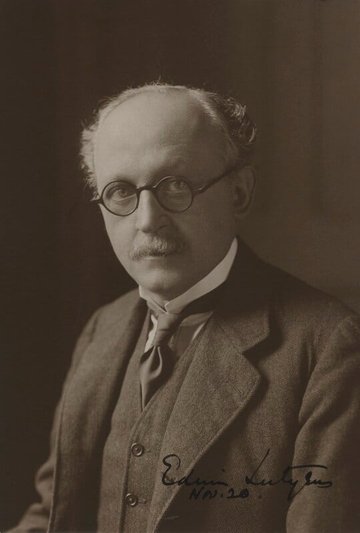
Edwin Lutyens
‐
English architect who played a central role in constructing the imperial capital, New Delhi
Other names
Sir Edwin Landseer Lutyens
Ned Lutyens
Place of birth
Place of death
London
About
A period of enforced rest on account of a childhood bout of rheumatic fever, combined with a sheltered early life in Surrey, helped Edwin Lutyens gain an in-depth knowledge of traditional building methods and sketching skills. After an abortive enrolment at the National Art Training School and a brief connection with an architectural firm, Lutyens set up his own architectural practice in 1889 at the age of 19. In the early stages of his career Lutyens designed many country houses, often with gardens designed by his mentor Gertrude Jekyll. He was heralded as a new light in British rural architecture, and courted by such establishment icons as Country Life and Edward Hudson, owner of Lindisfarne Castle, which Lutyens restored.
In April 1897 Lutyens married Lady Emily Bulwer-Lytton, daughter of the late Viceroy of India, Edward Bulwer-Lytton. They had five children, but the marriage experienced a period of near-estrangement on account of Emily’s heavy involvement with Theosophy and devotion to the spiritual leader Jiddu Krishnamurti. Later, Emily established an All-India Home Rule movement, somewhat at odds with Lutyens’ role as architect for the new capital. They were reconciled in the early 1930s, after Lutyens’ close friendship with Lady Sackville-West.
Lutyens sought for some time larger-scale international works, and was successful in designing the Johannesburg Art Gallery (1911–40) and the British Pavilion at the International Exhibition in Rome (1911). In 1912 Lutyens was invited to join the commission responsible for the design of New Delhi, given the announcement the previous year that the Government of India would move there from Calcutta. Lord Crewe, the Indian Secretary, was familiar with Lutyens’s work in Hampstead. Lutyens travelled to India in 1912 and explored Delhi, Bombay and Simla, returning several times as he mapped out his vast city plan. The Viceroy’s House, now Rashtrapati Bhavan, official residence of the President of India, is Lutyens’ masterpiece. Despite his initial misgivings about Mughal architecture, the finished building fuses Mughal and Hindu elements, as well as the Buddhist railing from the stupa at Sanchi around the central dome. The building contains approximately 340 rooms and is built on an area of 1.3 square kilometres. The garden was designed by Lutyens. During the building process, Lutyens and his fellow architect Herbert Baker made annual winter visits to India until forced to cease for the duration of the First World War. This and other delays meant that the Viceroy’s House was not completed until 1929, and the city inaugurated in 1931, a ceremony which Lutyens attended with his wife.
Lutyens is also remembered in Europe for his work with the Imperial War Graves Commission, and the design of the Cenotaph on Whitehall, the war cemeteries including Étaples and the Faubourg d'Amiens cemetery at Arras, and, perhaps most striking of all, the Thiepval Arch, memorial to the missing soldiers from the Battle of the Somme.
Atul Bose, Mukul Dey, Lord Hardinge (Viceroy of India), Jiddu Krishnamurti, J. A. Lalkaka, Emily Lutyens (wife), Firoz Khan Noon.
Royal Academy, Royal Institute of British Architects.
Houses and Gardens (London: Country Life, 1914)
Fulbrook: 'A House You Will Love to Live In'. The Sketchbook, Letters, Specifications of Works & Accounts for a House by Edwin Lutyens, 1896–1899, ed. by Jane Brown (Marlborough: Libanus Press, 1989)
The Architecture of Sir Edwin Lutyens, 3 vols (London: Country Life, 1950)
Byron, R, ‘New Delhi’, Architectural Review 69 (1931)
Hopkins, Andrew and Stamp, Gavin (eds) Lutyens Abroad: The Work of Sir Edwin Lutyens Outside the British Isles (London: British School at Rome at the British Academy, 2002)
Hussey, Christopher, The Life of Sir Edwin Lutyens (Woodbridge: Antique Collectors’ Club, 1984)
Irving, Robert Grant, Indian Summer: Lutyens, Baker and Imperial Delhi (New Haven, CT and London: Yale University Press, 1981)
Lutyens, Emily, Candles in the Sun (London: Rupert Hart-Davis, 1957)
Lutyens, Mary, Edwin Lutyens by His Daughter (London: John Murray, 1980)
Lutyens, Robert, Sir Edwin Lutyens: An Appreciation in Perspective (London: Country Life, 1942)
Jekyll, Gertrude, Home and Garden (London: Longmans, 1901)
Muthesius, Hermann, The English House, ed. by D. Sharp, trans. by J. Seligman (London: Crosby Lockwood Staples, [1908–11] 1979)
Percy, Clayre and Ridley, Jane, The Letters of Edwin Lutyens to His Wife Lady Emily (London: Collins, 1985)
Pevsner, Sir Nikolaus, ‘Building with Wit: The Architecture of Sir Edwin Lutyens, Architectural Review 111 (1951), pp. 217–23
‘Reminiscences on Sir Edwin Lutyens,’ Architectural Association Journal 74 (March 1959), pp. 226–36
Ridley, Jane, The Architect and His Wife: A Life of Edwin Lutyens (London: Chatto & Windus, 2002)
Weaver, Lawrence, Houses and Gardens by E. L. Lutyens (London: Country Life, 1913)
Caricatures, sketches and letters to Lewis family, Bodleian Library, Oxford
Correspondence and papers, Royal Institute of British Architects, British Architectural Library, London
Letters to Lord Hardinge, Cambridge University Library, Cambridge
Letters and plans, Centre for Kentish Studies, Maidstone, Kent
Correspondence and letters relating to work for Imperial War Graves Commission, Commonwealth War Graves Commission, Maidenhead
Letters to Lord Lothian, National Archive of Scotland, Edinburgh
Comprehensive lists of works by and about Lutyens, gallery of works and current preservation campaigns, http://www.lutyenstrust.org.uk
Image credit
Sir Edwin Lutyens by unknown photographer, print, circa 1920, NPG x14274
© National Portrait Gallery, London, Creative Commons, http://creativecommons.org/licenses/by-nc-nd/3.0/
